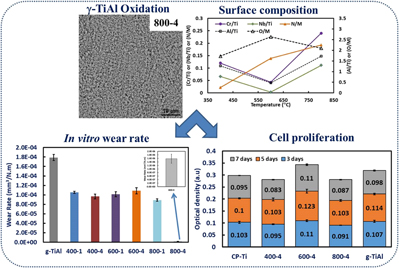Crossref Citations
This article has been cited by the following publications. This list is generated based on data provided by
Crossref.
Koopaie, Maryam
Kia Darbandsari, Ali
Hakimiha, Neda
and
Kolahdooz, Sajad
2020.
Er,Cr:YSGG laser surface treatment of gamma titanium aluminide: Scanning electron microscopy–energy-dispersive X-ray spectrometer analysis, wettability and Eikenella corrodens and Aggregatibacter actinomycetemcomitans bacteria count—in vitro study.
Proceedings of the Institution of Mechanical Engineers, Part H: Journal of Engineering in Medicine,
Vol. 234,
Issue. 8,
p.
769.
Casadebaigt, Antoine
Hugues, Jonathan
and
Monceau, Daniel
2020.
High temperature oxidation and embrittlement at 500–600 °C of Ti-6Al-4V alloy fabricated by Laser and Electron Beam Melting.
Corrosion Science,
Vol. 175,
Issue. ,
p.
108875.
Kuo, Cheng-Hsien
Chen, Tao-Hsing
and
Zeng, Ting-Yang
2021.
Effects of Cu Addition on Mechanical Behaviour, Microstructural Evolution and Anti-Corrosion Performance of TiAl-Based Intermetallic Alloy under Different Strain Rates.
Materials,
Vol. 14,
Issue. 17,
p.
5056.
Yang, Hsin-Feng
Chen, Tao-Hsing
and
Syu, Ying-Ying
2022.
Mechanical Properties and Microstructural Evolution of TiNi-Based Intermetallic Alloy with Nb Addition.
Materials,
Vol. 15,
Issue. 9,
p.
3124.
Galati, Manuela
Gatto, Maria Laura
Bloise, Nora
Fassina, Lorenzo
Saboori, Abdollah
Visai, Livia
Mengucci, Paolo
and
Iuliano, Luca
2022.
Biocompatibility of Ti-48Al-2Cr-2Nb produced by electron beam powder bed fusion (EB-PBF).
Materials Today: Proceedings,
Vol. 70,
Issue. ,
p.
483.
Karimi, Paria
Keshavarz, Mohsen K.
Sadeghi, Esmaeil
Habibnejad, Mahdi
and
Vlasea, Mihaela
2023.
Interplay of process, microstructure, and mechanical performance in electron beam-powder bed fusion of Ti48Al2Nb2Cr.
Additive Manufacturing,
Vol. 77,
Issue. ,
p.
103811.
Estupinán-López, Francisco
Orquiz-Muela, Carlos
Gaona-Tiburcio, Citlalli
Cabral-Miramontes, Jose
Bautista-Margulis, Raul German
Nieves-Mendoza, Demetrio
Maldonado-Bandala, Erick
Almeraya-Calderón, Facundo
and
Lopes, Amit Joe
2023.
Oxidation Kinetics of Ti-6Al-4V Alloys by Conventional and Electron Beam Additive Manufacturing.
Materials,
Vol. 16,
Issue. 3,
p.
1187.
Zhu, Yuming
Song, Xiaojie
Liu, Minglei
Jia, Wenchang
Yin, Zeliang
Wang, Quanzhi
Zhang, Yuhao
Jiang, Di
Song, Qiang
and
Cui, Hongzhi
2023.
Improved wear resistance of TiAl composite coatings through NbC@(Ti,Nb)2AlC core-shell structure and nanoscale precipitation strengthening.
Vacuum,
Vol. 213,
Issue. ,
p.
112091.
Xu, Xincheng
Li, Zheng
Lai, Weiji
Wang, Binbin
Xu, Qihang
Zhang, Zhiguo
You, Deqiang
Li, Wei
and
Wang, Xiaojian
2023.
Improved wear and corrosion resistance of biomedical TiZrNbTaMo medium-entropy alloy by thermal oxidation treatment.
Tribology International,
Vol. 189,
Issue. ,
p.
108897.
Galati, Manuela
Gatto, Maria Laura
Bloise, Nora
Fassina, Lorenzo
Saboori, Abdollah
Visai, Livia
Mengucci, Paolo
and
Iuliano, Luca
2024.
Electron Beam Powder Bed Fusion of Ti-48Al-2Cr-2Nb Open Porous Scaffold for Biomedical Applications: Process Parameters, Adhesion, and Proliferation of NIH-3T3 Cells.
3D Printing and Additive Manufacturing,
Vol. 11,
Issue. 1,
p.
314.
Nasiri-Tabrizi, Bahman
Basirun, Wan Jefrey
Walvekar, Rashmi
Yeong, Chai Hong
and
Phang, Siew Wei
2024.
Exploring the potential of intermetallic alloys as implantable biomaterials: A comprehensive review.
Biomaterials Advances,
Vol. 161,
Issue. ,
p.
213854.



